Trigger queries
A trigger query consists of at least one comparison clause. You can add a simple clause, a compund clause, or both. You can add as many clauses and compound clauses as you need. For each set of clauses, you specify whether the set is satisfied when all or any of its comparison clauses are satisfied.
Note
The Actions service doesn't check queries for consistency. For example, a trigger query that specifies "severity equal to critical and severity equal to error" isn't marked as an error, even though it's inconsistent.
Trigger query builder
Decide if you want your query to return true if Any of the values meet the conditions or only if All the values meet the conditions. Then add your comparison clauses:
- To add a simple clause, click the Add simple clause (plus sign) button.
- To add a compound clause, click the Add compound clause (return arrow) button.
To define the clauses, click in the first field to select an entity, metric, or other field name. This field offers suggestions based on the user-friendly names in the Dictionary or from live data in your system. The suggestions are also grouped by type for quicker browsing.
When you select the field name, the query builder automatically adjusts the operators available in the clause. For example, a field that is a string type has different operators than a field that is a numeric type.
Select your operator, then select your value. Start typing in the value field for autosuggestions based on your selected field name and operator.
To add another simple clause or add a compound clause, use the buttons in the top of your query. To remove all the clauses, click the X button in the top of the query.
The following example shows the query builder in the ADD TRIGGER dialog box, but the same query builder is used in other Virtana features, such as defining datasources for policies and creating an event.
The following table describes the major components of the query builder.
| Item | Description |
|---|---|
| Comparison clause sets | A trigger query consists of one or more comparison clauses. This example shows two sets. When you click the **Add simple clause** (plus sign icon), you can add simple clauses to the comparison set. Click the **Add compound clause** (return arrow icon) to add another comparison set. The comparisons in a child set are evaluated when the comparisons in its parent set are satisfied. |
| Relationship type | Set the logic for joining comparisons and the child set, if any.
|
| Clause | For each comparison clause, select the field, operator, and value.
|
Example event query
The following event query includes two sets of comparisons:
The following text summarizes the logic of the preceding query:
"Source Type" equal to "cz"AND
"Summary" contains "periphery"AND
"Acknowledged" not equal to True
AND
"Severity" greater than or equal to "error"OR
"Status" not equal to "closed"
The parent set includes three comparisons, all of which must be satisfied. The child set includes two comparisons, either one of which must be satisfied. The child set is not evaluated unless the parent set is satisfied.
Anomaly trigger fields
The following table describes the fields available in the query builder for anomaly triggers.
| Field | Description |
|---|---|
| Metric Name | The name of a metric. |
| Metric ID | The unique identifier of a metric. |
| Entity ID | The unique identifier of an entity. |
| Entity Title | The name of an entity. |
| Device Name | The Collection Zone device name of an entity. |
| Device Class | The name of the Collection Zone device class. |
| Group | The name of the Collection Zone Groups organizer. |
| System | The name of the Collection Zone Systems organizer. |
| Location | The name of the Collection Zone Locations organizer. |
| Source Type | The class name of the application sending data to Virtana Service Observability. For Collection Zones, the value is |
| Production State | The entity production state. Typically, the value is one of |
Event trigger fields
The following table describes the fields available in the query builder for event triggers.
Note
These are just some of the typical fields that are available. More fields might be available in your system if the field is part of your streaming data or if you added it to the Dictionary.
| Field | Description |
|---|---|
| Severity | The event severity level. The value is one of |
| Status | The event status. The value is one of |
| Acknowledged | A value that indicates whether the event has been acknowledged.
|
| Summary | The event summary. |
| Body | The body of the event message. |
| Type | (Sources other than Collection Zones only) Information about the event type. |
| Name | The event name. |
| Source | The instance identifier of the source type. For example, cz0. |
| CZ Event Class | The name of the Collection Zone event class associated with the event, either at creation or during a subsequent mapping. Each Collection Zone can have its own set of customized event classes. |
| CZ Message | The body of the Collection Zone event message. |
| CZ Entity Type | The type of Collection Zone entity from which the event originated. The value is one of |
| CZ Parent Entity Type | The type of the Collection Zone parent entity from which the event originated. The value is one of |
| CZ Parent Entity Title | The title of the Collection Zone parent entity from which the event originated. |
| CZ Parent Entity ID | The Collection Zone ID of the parent entity from which the event originated. |
| CZ Production State | The Collection Zone production state name, if the state is one of the default states. The value is one of |
| CZ Production State (Custom) | A number that represents a customized Collection Zone production state. Each Collection Zone can have its own set of customized production states. |
| CZ Priority | The Collection Zone device priority, if the priority is one of the default priorities. The value is one of |
| CZ Priority (Custom) | A number that represents a customized Collection Zone device priority. Each Collection Zone can have its own set of customized device priorities. |
| CZ Collector | The name of the Collection Zone collector where the event originated. |
| CZ Agent | The name of the Collection Zone service that generated the event. For example, |
| Entity ID | The ID of the entity associated with the event. |
| Entity Title | The name of the entity associated with the event. |
| Device Name | The device name of the entity associated with the event. |
| Device Class | The name of the Collection Zone device class to which the entity associated with the event belongs. |
| Group | The name of the Collection Zone Groups organizer to which the entity associated with the event belongs. |
| System | The name of the Collection Zone Systems organizer to which the entity associated with the event belongs. |
| Location | The name of the Collection Zone Locations organizer to which the entity associated with the event belongs. |
| Source Type | The class name of the entity associated with the event. For Collection Zone entities, the value is |
Metric trigger fields
The following table describes the fields available in the query builder for metric triggers.
| Field | Description |
|---|---|
| Metric ID | The unique identifier of a metric. |
| Entity ID | The unique identifier of the entity associated with the metric. |
| Entity Title | The name of the entity associated with the metric. |
| Device Name | The device name of the entity associated with the metric. |
| Device Class | The name of the Collection Zone device class to which the entity associated with the metric belongs. |
| Group | The name of the Collection Zone Groups organizer to which the entity associated with the metric belongs. |
| System | The name of the Collection Zone Systems organizer to which the entity associated with the metric belongs. |
| Location | The name of the Collection Zone Locations organizer to which the entity associated with the metric belongs. |
| Source Type | The class name of the entity associated with the metric. For Collection Zone entities, the value is |
| Production State | The production state of the entity associated with the metric. Typically, the value is one of |


